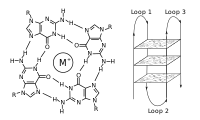
Photo from wikipedia
The inhibition of DNA topoisomerase I (Top1) has proven to be a successful approach toward the design of anticancer agents. Indenoisoquinoline derivatives have been designed and developed as Top1 inhibitors… Click to show full abstract
The inhibition of DNA topoisomerase I (Top1) has proven to be a successful approach toward the design of anticancer agents. Indenoisoquinoline derivatives have been designed and developed as Top1 inhibitors and can overcome some shortcomings associated with the camptothecin Top1 inhibitors, resulting in three indenoisoquinoline compounds, indotecan (LMP 400), indimitecan (LMP776), and LMP744 entering Phase I clinical trials at the National Cancer Institute. However, some active indenoisoquinolines did not show potent Top1 inhibition, suggesting a separate mechanism of action. c-Myc is one of the most commonly deregulated genes in human cancers; a DNA G-quadruplex (G4) formed in the proximal promoter region of c-Myc has been found to function as a transcriptional silencer and be amenable to small molecule targeting. As indenoisoquinolines share structure similarity to our c-Myc G-quadruplex (MycG4)-interactive compounds, we hypothesized that indenoisoquinolines could stabilize MycG4 and downregulate MYC transcription. Using a fluorescence resonance energy transfer (FRET) assay, we examined the MycG4 stabilization activity of 56 indenoisoquinoline compounds that we previously developed as Top1 inhibitors. Notably, 26 of the 56 compounds decreased the fluorescence intensity by at least 50%, and the 10 most potent compounds reduced fluorescence intensities by over 70%, indicating that these indenoisoquinolines are effective MycG4 stabilizers. The identified compounds were further characterized by fluorescence anisotropy, circular dichroism, and nuclear magnetic resonance for MycG4 interactions, followed by western blot assays for MYC downregulation. Significantly, the compounds with good MycG4 binding activity and affinity exhibited significant dose-dependent reduction of MYC expression, indicating that targeting the c-Myc promoter G-quadruplex is a likely mechanism of action for these active anticancer compounds. Furthermore, some active indenoisoquinolines exhibited both MYC downregulation and Top1 inhibition, suggesting that dual targeting c-Myc G-quadruplex and Top1 may represent a novel mechanism of action for anticancer drug design. Citation Format: Kaibo Wang, Mohamed S. A. Elsayed, Guanhui Wu, Mark Cushman, Danzhou Yang. Indenoisoquinoline topoisomerase I inhibitors target the DNA G-quadruplex formed in the c-Myc promoter and cause MYC downregulation [abstract]. In: Proceedings of the American Association for Cancer Research Annual Meeting 2018; 2018 Apr 14-18; Chicago, IL. Philadelphia (PA): AACR; Cancer Res 2018;78(13 Suppl):Abstract nr 2662.
Journal Title: Cancer Research
Year Published: 2018
Link to full text (if available)
Share on Social Media: Sign Up to like & get
recommendations!